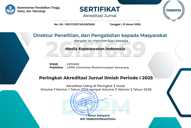Aerobic Exercise Reduce Blood Glucose in Type 2 Diabetes Mellitus
(1) Universitas Muhammadiyah Semarang
(2) Universitas Muhammadiyah Semarang
(*) Corresponding Author
Abstract
Keywords
Full Text:
PDFReferences
International Diabetic Federation. IDF Diabetes atlas 9th edition. 9th ed. Belgium: International Diabetes Federation; 2019.
International Diabetic Federation. IDF Diabetes atlas 7th edition. 7th ed. Belgium: International Diabetes Federation; 2015.
International Diabetic Federation. IDF Diabetes atlas 8th edition. 8th ed. Belgium: International Diabetes Federation; 2017. https://doi.org/http://dx.doi. org/10.1016/S0140-6736(16)31679-8.
Balitbang Kemenkes RI. Riset Kesehatan Dasar; Riskesdas 2018. Jakarta: 2018.
American Diabetes Association. American diabetes association standards of medical care in diabetes-2017. Diabet Care J Clin Appl Res Educ 2017;40:1–142.
Hinkle JL, Cheever KH. Brunner & Suddarth’s Textbook of Medical-Surgical Nursing. 14th ed. Philadelphia: Wolters Kluwer; 2018.
Behroozian A, Beckman JA. Microvascular Disease Increases Amputation in Patients With Peripheral Artery Disease. Arterioscler Thromb Vasc Biol 2020;40:534–40. https://doi.org/10.1161/ATVBAHA.119.312859.
Iqbal Z, Azmi S, Yadav R, Ferdousi M, Kumar M, Cuthbertson DJ, et al. Diabetic Peripheral Neuropathy: Epidemiology, Diagnosis, and Pharmacotherapy. Clin Ther 2018;40:828–49. https://doi.org/10.1016/j.clinthera.2018.04.001.
American Diabetes Association. Factors Affecting Blood Glucose. Diabetes Care 2015;16:2383.
Teich T, Zaharieva DP, Riddell MC. Advances in Exercise, Physical Activity, and Diabetes Mellitus. Diabetes Technol Ther 2019;21:S112–22. https://doi.org/10.1089/dia.2019.2509.
Perkeni. Pedoman pengelolaan dan pencegahan diabetes melitus tipe 2 dewasa di indonesia 2019 2019:133.
American Diabetes Association. Standards of medical care in diabetes-2020. J Clin Appl Res Educ 2020;42:960–1010. https://doi.org/10.1192/bjp.111.479.1009-a.
Riebe D, Ehrman JK, Ligouri G, Magal M. ACSM’s guidline for exercise testing and prescription. 10th ed. Philadelphia: Wolters Kluwer; 2018. https://doi.org/10.5860/choice.35-6295.
Olson RD, Piercy KL, Troiano RP, Ballard RM, Fulton JE, Galuska DA, et al. Physical activity guidelines for Americans. 2nd ed. U.S. Department of Health and Human Services; 2018. https://doi.org/10.1249/fit.0000000000000472.
Kawada T. Effect of high-intensity aerobic exercise on aerobic fitness and HbA1c in patients with type 2 diabetes. Eur J Appl Physiol 2017;117:1519–20. https://doi.org/10.1007/s00421-017-3632-y.
Colberg SR, Sigal RJ, Yardley JE, Riddell MC, Dunstan DW, Dempsey PC, et al. Physical activity/exercise and diabetes: A position statement of the American Diabetes Association. Diabetes Care 2016;39:2065–79. https://doi.org/10.2337/dc16-1728.
Mirtha LT, Permatahati V. The Effectiveness of Aerobic Exercise in Improving Peripheral Nerve Functions in Type 2 Diabetes Mellitus: An Evidence Based Case Report. Acta Med Indones 2018;50:82–7.
Singleton JR, Smith AG, Marcus RL. Exercise as Therapy for Diabetic and Prediabetic Neuropathy. Curr Diab Rep 2015;15:1–8. https://doi.org/10.1007/s11892-015-0682-6.
Gu Y, Dennis SM, Kiernan MC, Harmer AR. Aerobic exercise training may improve nerve function in type 2 diabetes and pre-diabetes: A systematic review. Diabetes Metab Res Rev 2019;35. https://doi.org/10.1002/dmrr.3099.
Tharek Z, Ramli AS, Whitford DL, Ismail Z, Mohd Zulkifli M, Ahmad Sharoni SK, et al. Relationship between self-efficacy, self-care behaviour and glycaemic control among patients with type 2 diabetes mellitus in the Malaysian primary care setting. BMC Fam Pract 2018;19:1–10. https://doi.org/10.1186/s12875-018-0725-6.
Singh R, Pattisapu A, Emery MS. US Physical Activity Guidelines: Current state, impact and future directions. Trends Cardiovasc Med 2020;30:407–12. https://doi.org/10.1016/j.tcm.2019.10.002.
Karstoft K, Clark MA, Jakobsen I, Müller IA, Pedersen BK, Solomon TPJ, et al. The effects of 2 weeks of interval vs continuous walking training on glycaemic control and whole-body oxidative stress in individuals with type 2 diabetes: a controlled, randomised, crossover trial. Diabetologia 2016;60:508–17. https://doi.org/10.1007/s00125-016-4170-6.
Fayehun AF, Olowookere OO, Ogunbode AM, Adetunji AA, Esan A. Walking prescription of 10 000 steps per day in patients with type 2 diabetes mellitus: A randomised trial in Nigerian general practice. Br J Gen Pract 2018;68:e139–45. https://doi.org/10.3399/bjgp18X694613.
Shakil-ur-Rehman S, Karimi H, Gillani SA, Amjad I, Ahmad S, Yaseen A. Response to a Supervised Structured Aerobic Exercise Training Program in Patients with Type 2 Diabetes Mellitus – Does Gender Make a Difference? A Randomized Controlled Clinical Trial. J Natl Med Assoc 2018;110:431–9. https://doi.org/10.1016/j.jnma.2017.10.003.
Lee SF, Pei D, Chi MJ, Jeng C. An investigation and comparison of the effectiveness of different exercise programmes in improving glucose metabolism and pancreatic β cell function of type 2 diabetes patients. Int J Clin Pract 2015;69:1159–70. https://doi.org/10.1111/ijcp.12679.
Pahra D, Sharma N, Ghai S, Hajela A, Bhansali S, Bhansali A. Impact of post-meal and one-time daily exercise in patient with type 2 diabetes mellitus: A randomized crossover study. Diabetol Metab Syndr 2017;9:5–11. https://doi.org/10.1186/s13098-017-0263-8.
Mendes R, Sousa N, Themudo-Barata JL, Reis VM. High-intensity interval training versus moderate-intensity continuous training in middle-aged and older patients with type 2 diabetes: A randomized controlled crossover trial of the acute effects of treadmill walking on glycemic control. Int J Environ Res Public Health 2019;16:1–14. https://doi.org/10.3390/ijerph16214163.
Cheng LJ, Wang W, Lim ST, Wu VX. Factors associated with glycaemic control in patients with diabetes mellitus: A systematic literature review. J Clin Nurs 2019;28:1433–50. https://doi.org/10.1111/jocn.14795.
Huebschmann AG, Huxley RR, Kohrt WM, Zeitler P, Regensteiner JG, Reusch JEB. Sex differences in the burden of type 2 diabetes and cardiovascular risk across the life course. Diabetologia 2019;62:1761–72. https://doi.org/10.1007/s00125-019-4939-5.
Keke L. Factors Influencing Glycemic Control among Chinese Adults With Type 2 Diabetes Mellitus BY KEKE LIN Bachelor of Medicine , Peking University , China , 2001 M . S . N ., University of Illinois at Chicago , 2006 THESIS Submitted as partial fulfillment of th 2017.
Demoz GT, Gebremariam A, Yifter H, Alebachew M, Niriayo YL, Gebreslassie G, et al. Predictors of poor glycemic control among patients with type 2 diabetes on follow-up care at a tertiary healthcare setting in Ethiopia. BMC Res Notes 2019;12:1–8. https://doi.org/10.1186/s13104-019-4248-6.
Lee SK, Shin DH, Kim YH, Lee KS. Effect of diabetes education through pattern management on self-care and self-efficacy in patients with type 2 diabetes. Int J Environ Res Public Health 2019;16. https://doi.org/10.3390/ijerph16183323.
Critchley JA, Carey IM, Harris T, DeWilde S, Hosking FJ, Cook DG. Glycemic control and risk of infections among people with type 1 or type 2 diabetes in a large primary care cohort study. Diabetes Care 2018;41:2127–35. https://doi.org/10.2337/dc18-0287.
Aghili R, Polonsky WH, Valojerdi AE, Malek M, Keshtkar AA, Esteghamati A, et al. Type 2 Diabetes: Model of Factors Associated with Glycemic Control. Can J Diabetes 2016;40:424–30. https://doi.org/10.1016/j.jcjd.2016.02.014.
Alaidarous TA, Alkahtani NM, Aljuraiban GS, Abulmeaty MMA. Impact of the Glycemic Control and Duration of Type 2 Diabetes on Vitamin D Level and Cardiovascular Disease Risk. J Diabetes Res 2020;2020. https://doi.org/10.1155/2020/8431976.
Zaidi A, Singh SP, Raza ST, Mahdi F. Role of Hba1C in the Diagnosis of Patients With Diabetes Mellitus. Era’s J Med Res 2019;6:78–83. https://doi.org/10.24041/ejmr2019.134.
Yuan X, Dai X, Liu L, Hsue C, Miller JD, Fang Z, et al. Comparing the effects of 6 months aerobic exercise and resistance training on metabolic control and β-cell function in Chinese patients with prediabetes: A multicenter randomized controlled trial. J Diabetes 2020;12:25–37. https://doi.org/10.1111/1753-0407.12955.
Cigarroa I, Espinoza-Sanhueza MJ, Lasserre-Laso N, Diaz-Martinez X, Garrido-Mendez A, Matus-Castillo C, et al. Association between walking pace and diabetes: Findings from the chilean national health survey 2016–2017. Int J Environ Res Public Health 2020;17:1–10. https://doi.org/10.3390/ijerph17155341.
Mathew TK, Tadi P. Blood Glucose Monitoring. StatPearls Publ 2020.
Ortega JF, Morales-Palomo F, Ramirez-Jimenez M, Moreno-Cabañas A, Mora-Rodríguez R. Exercise improves metformin 72-h glucose control by reducing the frequency of hyperglycemic peaks. Acta Diabetol 2020;57:715–23. https://doi.org/10.1007/s00592-020-01488-7.
Delevatti RS, Kanitz AC, Alberton CL, Marson EC, Lisboa SC, Pinho CDF, et al. Glucose control can be similarly improved after aquatic or dry-land aerobic training in patients with type 2 diabetes: A randomized clinical trial. J Sci Med Sport 2016;19:688–93. https://doi.org/10.1016/j.jsams.2015.10.008.
Asuako B, Moses MO, Eghan BA, Sarpong PA. Fasting plasma glucose and lipid profiles of diabetic patients improve with aerobic exercise training. Ghana Med J 2017;51:120–7. https://doi.org/10.4314/gmj.v51i3.5.
Teo SYM, Kanaley JA, Guelfi KJ, Marston KJ, Fairchild TJ. The Effect of Exercise Timing on Glycemic Control: A Randomized Clinical Trial. vol. 52. 2020. https://doi.org/10.1249/MSS.0000000000002139.
Li Z, Hu Y, Yan R, Zhang D, Li H, Li F, et al. Twenty minute moderate-intensity post-dinner exercise reduces the postprandial glucose response in Chinese patients with type 2 diabetes. Med Sci Monit 2018;24:7170–7. https://doi.org/10.12659/MSM.910827.
Solomon TPJ, Tarry E, Hudson CO, Fitt AI, Laye MJ. Immediate post-breakfast physical activity improves interstitial postprandial glycemia: a comparison of different activity-meal timings. Pflugers Arch Eur J Physiol 2020;472:271–80. https://doi.org/10.1007/s00424-019-02300-4.
Duvivier BMFM, Schaper NC, Hesselink MKC, van Kan L, Stienen N, Winkens B, et al. Breaking sitting with light activities vs structured exercise: a randomised crossover study demonstrating benefits for glycaemic control and insulin sensitivity in type 2 diabetes. Diabetologia 2017;60:490–8. https://doi.org/10.1007/s00125-016-4161-7.
Zheng X, Qi Y, Bi L, Shi W, Zhang Y, Zhao D, et al. Effects of Exercise on Blood Glucose and Glycemic Variability in Type 2 Diabetic Patients with Dawn Phenomenon. Biomed Res Int 2020;2020. https://doi.org/10.1155/2020/6408724.
Sylow L, Kleinert M, Richter EA, Jensen TE. Exercise-stimulated glucose uptake-regulation and implications for glycaemic control. Nat Rev Endocrinol 2017;13:133–48. https://doi.org/10.1038/nrendo.2016.162.
Kirwan JP, Sacks J, Nieuwoudt S. The essential role of exercise in the management of type 2 diabetes. Cleve Clin J Med 2017;84:S15–21. https://doi.org/10.3949/ccjm.84.s1.03.
Sampath Kumar A, Maiya AG, Shastry BA, Vaishali K, Ravishankar N, Hazari A, et al. Exercise and insulin resistance in type 2 diabetes mellitus: A systematic review and meta-analysis. Ann Phys Rehabil Med 2019;62:98–103. https://doi.org/10.1016/j.rehab.2018.11.001.
Rees JL, Chang CR, François ME, Marcotte-Chénard A, Fontvieille A, Klaprat ND, et al. Minimal effect of walking before dinner on glycemic responses in type 2 diabetes: outcomes from the multi-site E-PAraDiGM study. Acta Diabetol 2019;56:755–65. https://doi.org/10.1007/s00592-019-01358-x.
Cassidy S, Thoma C, Houghton D, Trenell MI. High-intensity interval training: a review of its impact on glucose control and cardiometabolic health. Diabetologia 2017;60:7–23. https://doi.org/10.1007/s00125-016-4106-1.
Huang T, Lu C, Schumann M, Le S, Yang Y, Zhuang H, et al. Timing of exercise affects glycemic control in type 2 diabetes patients treated with metformin. J Diabetes Res 2018;2018. https://doi.org/10.1155/2018/2483273.
Reynolds AN, Mann JI, Williams S, Venn BJ. Advice to walk after meals is more effective for lowering postprandial glycaemia in type 2 diabetes mellitus than advice that does not specify timing: a randomised crossover study. Diabetologia 2016;59:2572–8. https://doi.org/10.1007/s00125-016-4085-2.
Article Metrics
Abstract view : 878 timesPDF - 28 times
DOI: https://doi.org/10.26714/mki.5.1.2022.73-83
Refbacks
- There are currently no refbacks.
Copyright (c) 2022 Roni Sianturi, Akhmad Mustofa

This work is licensed under a Creative Commons Attribution 4.0 International License.
This journal is indexed by:
Kedungmundu Raya No. 18 Semarang NRC Building Universitas Muhammadiyah Semarang
Phone: 02476740287
Fax: 02476740287
Email: mki@unimus.ac.id





















